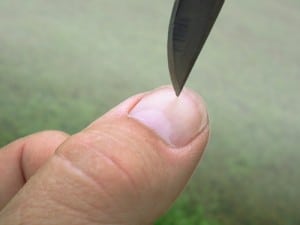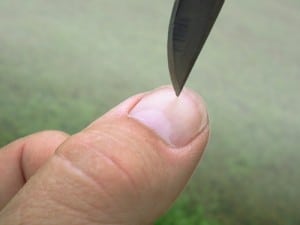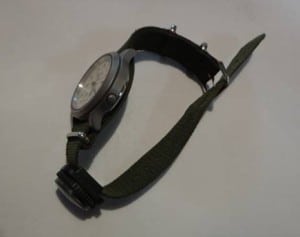You don’t really need a compass (and you may not always have one – though a compass and a self-winding watch are a good idea as they are two of the most reliable aids you can have). In the Southern Hemisphere the sun is always in the Northern (third) of the sky. At mid-day it should be pretty much due North.
You can estimate how far it has to travel (or has traveled) by measuring finger widths to the horizon, each finger representing approximately a quarter hour (at arm’s length). (This is just one of my ‘rules of thumb’). Usually it won’t matter if you are a few degrees off your route: you can’t travel very far in a single day anyway, and if you are lost for more than one day, something is seriously wrong, but if so, think about either heading in one direction (the closest known civilisation and/or following water downstream. If you were paying attention when you set out, and as you traveled along, you should always be able to find your way back to where you started that day. Just keeping in mind where a generally Northerly direction is, by the end of the day you should not be more than a couple of hundred metres from any destination you have chosen for the day. If you are not, you have not been paying attention.
You should note important landmarks on the way out, and turn around as you go out so that you can remember what they will look like on your return trip. This is VERY important and should never be ignored.
When you are walking you don’t need any more directions than (at most) the eight cardinal points of the compass. Usually your direction at any given time is determined by topography anyway, so that if you DO want to generally head in a particular direction, necessity will bend your course away from it either to the right or left. You will need to walk for approximately the same amount of time in the opposite (left or right) tendency to keep to your course anyway.
If you need to think more precisely about direction than that, here is another ‘rule of thumb’: the palm of your hand (at arm’s length) is approximately 15 degrees. The tip of your little finger at arm’s length is approximately 1 degree). Should you really need to know (precisely) where East and West are, shove a stick into the ground and mark the spot where the end of its shadow touches the ground. Mark the same spot say 15 minutes later. Draw a line between the two. That line is precisely East-West. Obviously North-South is precisely perpendicular to it.
If you cannot SEE the sun (because it is cloudy etc) often a stick will still cast a faint shadow on pale ground. If not a very small hole (eg made in a leaf) will ‘project’ the sun’s disc onto the ground. Looking around through such a small hole should enable you to work out where the brightest spot in the sky is.
A thumbdial, when you know the time of day tells you the direction of the sun, thus providing orientation. The secret of the thumbdial is that it reveals the sun’s location by revealing its shadow. Begin by standing in an open area and placing the tip of a knife blade on top of your thumbnail and rotate it slowly, watching for a slight shadow to be revealed on the matte textured surface. The location of the sun of course is on the opposite side of the knife blade from the shadow. The wide and narrow silhouette of the blade helps to accent this. The sun’s brightness is defused in fog but still maintains a brighter presence which is revealed by the very slight shadow.
If all else fails moss/lichen grows on the South side of trees/rocks in the Southern Hemisphere and on the opposite side (the one which gets least sunlight) in the Northern. Really though, if you can’t work out where the sun is, you probably shouldn’t be out there unchaperoned!
I bought these watch bands on eBay for $1.99. I think they are great because you don’t lose the watch if you snag it on some brush or a vine and tear out one of the pins (which happens). I also added a wrist compass ($3.99) which makes this Seiko auto-winder ($49.99) set-up just about perfect:
See Also:
http://www.theultralighthiker.com/how-to-light-a-fire-in-the-wet/
http://www.theultralighthiker.com/rope-dont-leave-home-without-it/
http://www.theultralighthiker.com/finding-your-way/
http://www.theultralighthiker.com/the-lie-of-the-land/
http://www.theultralighthiker.com/the-importance-of-a-roof/
http://www.theultralighthiker.com/carry-a-knife/
http://www.theultralighthiker.com/if-you-could-only-carry-two-things-in-the-bush-what-would-they-be/
http://www.theultralighthiker.com/ultralight-poncho-tent/
http://www.theultralighthiker.com/the-pocket-poncho-tent/
http://www.theultralighthiker.com/naismiths-rule/
http://www.theultralighthiker.com/weather-lore/
http://www.theultralighthiker.com/walking-the-line/
http://www.theultralighthiker.com/follow-your-nose/
http://www.theultralighthiker.com/how-long-till-sundown/
http://www.theultralighthiker.com/how-to-avoid-being-wet-cold-while-camping/
http://www.theultralighthiker.com/fire-on-the-snow/
http://www.theultralighthiker.com/river-crossings/
http://www.theultralighthiker.com/an-open-shelter/
http://www.theultralighthiker.com/raincoat-shelter/



